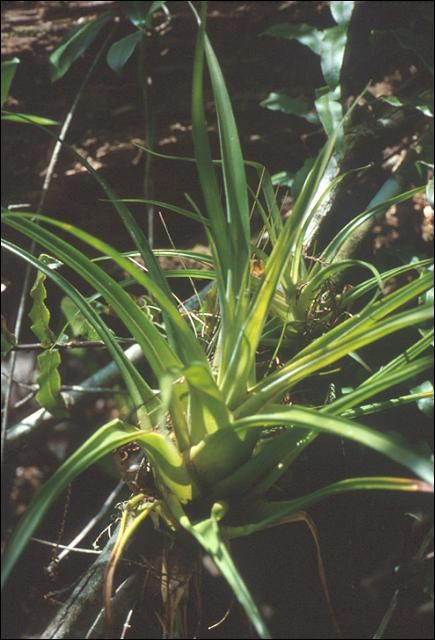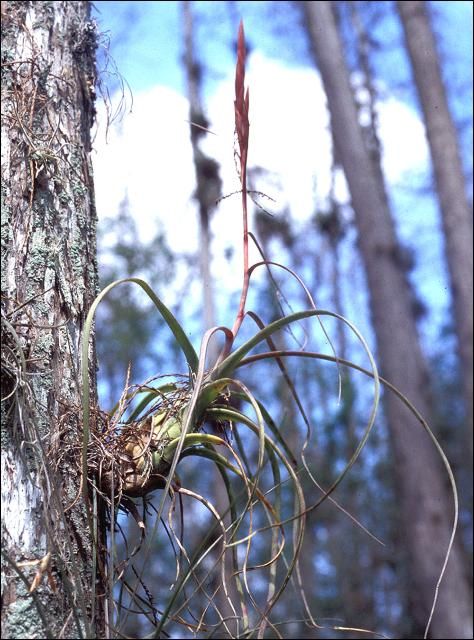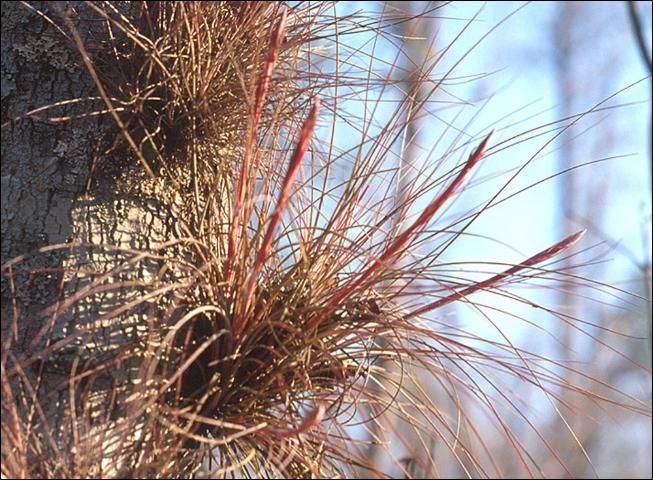Bromeliads are members of the pineapple family Bromeliaceae. They are perennial herbs that lack woody stems and typically grow on other plants or substrates. Bromeliads are not mosses as some of their common names suggest. They are flowering plants, although their blossoms can be very small.
All of Florida's 16 native bromeliad species and two natural hybrids (hybrids are produced when cross-pollination occurs between species, producing a new offspring) are epiphytic, which means they grow on other plants. Although epiphytes may attach root structures to their host plant, they do not parasitize the host plant; they simply use it for support.
Often called "air plants," bromeliads absorb surface minerals and water from specialized disc-shaped leaf structures called trichomes. Some Florida bromeliads are "tank" bromeliads that hold water between the leaf axils. Tanks are formed by many separate leaf axils (the space between the leaf and stem) or the central leaves together may form a large tank. Trapped plant materials (leaves, seeds, and twigs) are decomposed by bacteria and fungi and absorbed by the trichomes lining the bromeliad tanks. Sometimes found among these plant materials are dead and drowning non-aquatic insects, which also provide nutrients for the bromeliads. Catopsis berteroniana, a species of tank bromeliad found in south Florida, has evolved the ability to trap insects and use the nutrients to such a degree that it is essentially a carnivorous plant. Bromeliad tanks also provide habitat for mosquito larvae and various other invertebrate and small vertebrate animals. Consequently, bromeliads play important ecological roles, both as habitat and in nutrient recycling.
Ten of Florida's 16 native bromeliad species are listed as threatened or endangered. A threatened species is at risk of becoming endangered, and an endangered species is at risk of becoming extinct. Loss of habitat, illegal collecting of specimens from natural areas, and the non-native Mexican bromeliad weevil (Metamasius callizona) are the greatest threats to Florida's bromeliads. There is also a bromeliad weevil that is native to Florida (Metamasius mosieri); but whereas the native weevil does not typically kill the plant, the Mexican bromeliad weevil's larvae typically do. The rapid spread of the Mexican bromeliad weevil throughout south Florida is a potentially serious threat to these rare plants. For more information on the Mexican bromeliad weevil problem, please see the additional information section of this document and visit the "Save Florida's Native Bromeliads" website https://entnemdept.ufl.edu/frank/savebromeliads/.
This document describes the distinct features of each of Florida's 16 native bromeliads and notes specific conservation concerns. There are also two natural hybrids present in Florida, Tillandsia bartramii x fasciculata and Tillandsia balbisiana x fasciculata, which are not described in this document. We have used the symbol "~" to represent the word approximately when discussing length of leaves, bracts, flowers, and seed capsules.
Powdery Strap Airplant

Credit: J. H. Frank
Scientific name: Catopsis berteroniana
Also called: Powdery catopsis, West Indies catopsis, Yellow catopsis, Mealy wild pine
Status in Florida: endangered; rare
Threats in Florida: illegal collecting, Mexican bromeliad weevil, habitat loss
Range: Florida, Mexico, West Indies, Central and South America
Distribution in Florida: Collier, Dade, and mainland Monroe counties
Habitat: rockland hammock; slough; tidal swamp; prefers strong light, on high branches of host tree
Description: tank epiphyte; when flowering 16 in.; leaves yellow/green, to 18 in., white, chalky, powder covering, especially at the base; flowers 15–50, 3/8–1/2 in., white, on a stout scape, usually with 2–8 lateral branches; floral bracts 1/4–1/3 in., sepals 1/2 in. yellow-green; seed capsule ~ 1/2 in. long; seeds often germinate on the capsule
Time of flowering: all year, especially fall–winter
Fun facts: one of three known carnivorous bromeliads; slippery powder on leaf bases may aid in trapping insects
Florida Strap Airplant

Credit: J. H. Frank
Scientific name: Catopsis floribunda
Also called: Many-flowered catopsis, Many-flowered airplant, Florida catopsis
Status in Florida: endangered, rare
Threats in Florida: illegal collecting, habitat loss, Mexican bromeliad weevil
Range: Florida, Mexico, West Indies, Central and South America
Distribution in Florida: Broward, Collier, Dade, and Monroe counties
Habitat: humid, shady habitats; rockland hammocks; cypress swamps
Description: tank epiphyte; grows to 28 in. tall; leaves bright green, 8 in., with wide bases and narrowing at tip; flower stalk 10 in. or longer, with 5–15 lateral branches; flowers 15–50 yellow or white; seed capsules ½ in. long; vegetative in every month
Time of flowering: fall
Fun facts: soft leaves form a basal rosette; prefers shady spots on low tree branches.
Nodding Strap Airplant

Credit: B. Holst
Scientific name: Catopsis nutans
Also called: Nodding airplant, Nodding catopsis
Status in Florida: endangered, very rare
Threats in Florida: restricted range, illegal collecting, Mexican bromeliad weevil
Range: Florida, Mexico, West Indies, Central and South America
Distribution in Florida: Collier County
Habitat: shady, humid hammocks, deep cypress swamp, sloughs
Description: tank epiphyte; height 12 in; leaves small rosettes overlapping at bases, flexible, spreading, bright green, tapered to tip, 3–6 in. long, ¾ in. wide at base, chalky; flower stalk usually simple; flowers 3–10 orange/yellow, ¾ in.; capsules ½-¾ in. long, oval
Time of flowering: fall–spring (August–October)
Fun facts: flowers open at night; may only exist in the Fakahatchee Strand
West Indian Tufted Airplant

Credit: J. H. Frank
Scientific name: Guzmania monostachia
Also called: Fuchs bromeliad, Strap-leaved Guzmania, Striped torch
Status in Florida: endangered, restricted, seldom found but locally abundant
Threats in Florida: illegal collecting, Mexican bromeliad weevil
Range: Florida, West Indies, Mexico, Central America to northern Peru and Brazil
Distribution in Florida: Collier, Dade, mainland Monroe counties
Habitat: rockland hammock, slough, cypress swamp, most abundant on Pop ash (Fraxinus caroliniana) and Pond apple (Annona glabra) sloughs with peat soils
Description: Tank epiphyte; may be terrestrial; bright green, flexible, leaves taper at the tip, about 1 in. wide, usually 10–12 in., may have white stripes; single floral spike to 16 in.; many white flowers spirally arranged, 1 in.; salmon colored apical floral bracts; cylindrical seed capsules, 1½ in.
Time of flowering: all year, mainly February–August and especially May–July
Fun facts: 100 plants may appear on a single host tree; may produce many vegetative offshoots; genus name honors the 18th century Spanish naturalist Guzman
Leatherleaf Airplant

Credit: Barbra Larson
Scientific name: Tillandsia variabilis syn T. valenzuelana
Also called: Soft-leaved wild pine
Status in Florida: threatened, occasional
Threats in Florida: illegal collecting, Mexican bromeliad weevil, habitat loss
Range: Florida, West Indies, Mexico, Central and South America
Distribution in Florida: Broward, Collier, Hendry, Highlands, Martin, Dade, Monroe, Okeechobee counties
Habitat: shaded hammocks, cypress swamps
Description: tank epiphyte; plants usually single; 12–20 in tall; 15–20 soft leaves with fine scales, green/gray or silver (may have rose coloring), tapering; simple flower spike with reddish floral bracts 1 3/8 in. long), violet petals, and white sepals
Time of flowering: spring–fall
Fun facts: color of the flower spike depends greatly on the light level; summer colors are darker than fall
Giant Airplant

Credit: Barbra Larson
Scientific name: Tillandsia utriculata
Also called: Giant/Swollen wild pine; Spreading air plant
Status in Florida: endangered, frequent before Mexican bromeliad weevil
Threats in Florida: illegal collecting, Mexican bromeliad weevil, habitat loss
Range: Florida, West Indies, Mexico, Central/South America
Distribution in Florida: Volusia, Putnam, Flagler, Sumter, Lake, and Citrus counties, south to end of peninsula
Habitat: dry and mesic hammocks, cypress swamps, pinelands (often in bright exposed areas)
Description: tank epiphyte (may grow terrestrially); single plants, 6–12 ft.; 20–75 large, light-green to gray leaves (up to 31 in.) with wide base and scales; erect, zigzag branching flower spike (40–80 in.) 5–40 branches; floral bracts green or purple; 10–200 flowers, 1 in. petals white at base, violet at end; seed capsules up to 2 in.; monocarpic (single flower spike, releases seed and dies); low rate of vegetative reproduction
Time of flowering: spring to fall (especially summer)
Fun facts: after flower spike appears, seeds are released the following year in late spring; plant may live 20 years
Northern Needleleaf

Credit: Barbra Larson
Scientific name: Tillandsia balbisiana
Also called: Inflated wild pine, Reflexed wild pine, Cuttlefish, Balbis airplant
Status in Florida: threatened, occasionally found
Threats in Florida: Mexican bromeliad weevil, habitat loss
Range: Florida, Mexico, West Indies, Central and South America
Distribution in Florida: Orange, Osceola, Polk, Hillsborough, Manatee, Sarasota, DeSoto, Highlands, Okeechobee, Indian River, St. Lucie, Martin, Glades, Charlotte, Lee, Hendry, Palm Beach, Broward, Collier, Monroe, and Dade counties
Habitat: scrub, pinelands, cypress swamp, hammocks, mangroves, shell ridges/mounds
Description: Tank epiphyte; 28 in. tall, single or in clusters; 15–30 leaves, leathery, gray color due to scales, may be reddish; leaves slightly bulbous at base, tapering, curved or twisted at ends; flower spike usually 2–10 lateral branches, scape 3–12 in.; floral bracts bright red with violet petals, 5 flowers; seed capsules 1¾ in.
Time of flowering: fall-summer, especially early spring
Fun facts: on older plants, twisted and curved leaves interlock, forming a ball
Bartram's Airplant

Credit: J. H. Frank
Scientific name: Tillandsia bartramii, syn T. juncea, T. myriophylla
Status in Florida: frequently found
Range: Florida, Georgia, Caribbean, Mexico
Distribution in Florida: Alachua, Baker, Bradford, Citrus, Columbia, Dixie, Duval, Flagler, Franklin, Gilchrist, Gulf, Hernando, Highlands, Hillsborough, Indian River, Jefferson, Lafayette, Lake, Leon, Levy, Liberty, Manatee, Marion, Nassau, Orange, Osceola, Pasco, Polk, Putnam, Seminole, St. Johns, Sumter, Suwannee, Volusia, and Wakulla counties
Habitat: hammocks and pinelands
Description: epiphytic; 4–12 in. tall, 18–16 in. when flowering; plants clustered; 15 thin leathery, grayish leaves; flower spike simple or 1–5 side branches; pink to red floral bracts; violet petals; seed capsules ~1 inch long
Time of flowering: spring–summer (especially spring)
Fun facts: leaves resemble those of a wetland rush; Bartram was an early Florida naturalist
Cardinal Airplant

Credit: Barbra Larson
Scientific name: Tillandsia fasciculata syn T. hystricina
Also called: Quill-leaf airplant, Common wild pine, Clustered wild pine, Dog-drink-water.
Status in Florida: endangered; frequent before weevil
Threats in Florida: illegal collecting, Mexican bromeliad weevil, habitat loss
Range: Florida, West Indies, Mexico, Central and South America
Distribution in Florida: Brevard, Broward, Charlotte, Collier, DeSoto, Glades, Hardee, Hendry, Highlands, Hillsborough, Lee, Manatee, Martin, Dade, Monroe, Okeechobee, Orange, Osceola, Palm Beach, Pinellas, Polk, Sarasota, Seminole, and Volusia counties
Habitat: hammocks, cypress swamps, pinelands
Description: tank epiphyte, often in clusters; 20–50 long, stiff and leathery gray/green leaves, (12–28 in.), wider at brown base, tapering; flowering spike 12–24 in., 3–15 branches; floral bracts usually red but vary from yellow, green, to rose; 10–50 violet flowers, violet, rarely white, 1¾ in.; seed capsules ~ 1 in.; seeds windborne
Time of flowering: all year, especially spring to early summer
Fun facts: leaves longer in shade, plant smaller and more colorful in open sun
Twisted Airplant

Credit: J. H. Frank
Scientific name: Tillandsia flexuosa syn T. aloifolia
Also called: Banded/Striped airplant; Flexuous wild pine. Status in Florida: threatened, infrequent
Threats in Florida: illegal collecting, Mexican bromeliad weevil, habitat loss
Range: Florida, West Indies, Panama, Venezuela, Colombia
Distribution in Florida: Broward, Charlotte, Collier, Hendry, Highlands, Lee, Martin, Dade, Monroe, Palm Beach counties
Habitat: exposed areas, often coastal; xeric hammock, pinelands, scrub, shell mound, coastal berm, maritime hammock, tidal swamp, cypress swamp
Description: tank epiphyte; 8–31 in., bulbous base, gray leaves, twisted tips, white bands; zigzag flower stalk simple or few branches; spreading floral bracts; rose or purple flowers, 1½ in.; seed capsules 2 in. long.
Time of flowering: all year, except November and December, mostly spring to summer
Fun facts: flowers once, then reproduces vegetatively
Potbelly Airplant

Credit: J. H. Frank
Scientific name: Tillandsia paucifolia syn T. circinnata, T. bulbosa
Status in Florida: occasional
Threats in Florida: Mexican bromeliad weevil
Range: Florida, Mexico, West Indies, Central and South America
Distribution in Florida: Brevard, Broward, Charlotte, Collier, Hendry, Indian River, Lee, Manatee, Martin, Dade, Monroe, Okeechobee, Osceola, Palm Beach, Sarasota, and St. Lucie counties
Habitat: coastal strands and hammocks; exposed habitats, cypress swamps
Description: Tank epiphyte; 4–14 in. tall, single or in clusters; pseudobulbs; 5–10 long, twisted tapering gray leaves; simple flower spike 2–3 in., may have 2–4 branches, 2–15 lavender flowers ~1 in; leathery, pale pink floral bracts; brown, pointed seed capsules 1½ in. long
Time of flowering: spring–summer
Fun facts: only flowers once, then produces young sprout "pups" that feed off the mother plant until they drop off
Fuzzywuzzy Airplant

Credit: J. H. Frank
Scientific name: Tillandsia pruinosa syn T. breviscapa
Also called: Hoary airplant, Tropical airplant
Status in Florida: endangered, rare
Threats in Florida: illegal collecting, Mexican bromeliad weevil, habitat loss
Range: Florida, West Indies, Central and South America
Distribution in Florida: Collier county
Habitat: shady, humid hammocks, cypress swamps
Description: Tank epiphyte, pseudobulb, rarely clustered; 10 in. tall, 5–10 leaves; scales create white fuzzy appearance; flower spike simple; floral bracts pink, with 5 to many violet flowers, ~1 in.; seed capsule pointed and 3-sided, 1¾ in. long.
Time of flowering: All year, especially winter to spring
Fun facts: pointed scales give this plant its fuzziness; short flower stalks are sometimes hidden
Ball Moss

Credit: Barbra Larson
Scientific name: Tillandsia recurvata syn. Diaphoranthema recurvata
Status in Florida: common
Threats in Florida: none
Range: Arizona, Texas, Louisiana, Georgia, Florida, Mexico, Central America, West Indies, Argentina, Chile
Distribution in Florida: all counties
Habitat: Hammocks (prefer broad-leaved trees), pinelands, scrub; exposed areas
Description: Epiphytic; 5–7 in. tall, 6–7 in. wide; rooted crown, cluster of curving stems, compact leaves resulting in ball-like growth; leaves stiff, narrow, gray 2–5 blue to violet flowers on long central stem; seed capsule ~1 in. long
Time of flowering: spring
Fun fact: several plants often grow together in masses
Southern Needleleaf

Credit: J. H. Frank
Scientific name: Tillandsia setacea syn. T. tenuifolia
Also called: Needleleaf airplant
Status in Florida: common
Threats in Florida: none
Range: Florida, West Indies, Central and South America
Distribution in Florida: Brevard, Broward, Charlotte, Collier, DeSoto, Glades, Hardee, Hendry, Hernando, Highlands, Hillsborough, Indian River, Lake, Lee, Manatee, Martin, Dade, Monroe, Okeechobee, Orange, Osceola, Palm Beach, Pasco, Pinellas, Polk, Putnam, Sarasota, Seminole, St. Lucie, Sumter, and Volusia counties
Habitat: hammocks, swamps
Description: epiphytic, grows to 12 in. long, plants densely clustered, grow in small tufts; leaves swollen at base, curving tips, green to red; flower stalk 3–6 in.; 3–15 violet flowers, 1 in. long; seed capsules ~1 in.
Time of flowering: spring
Fun fact: similar to Tillandsia bartramii except for red tinting
Broad Needleleaf

Credit: J. H. Frank
Scientific name: Tillandsia simulata
Status in Florida: frequent; precinctive (found nowhere else)
Threats in Florida: possibly Mexican bromeliad weevil
Range: Florida
Distribution in Florida: Citrus, DeSoto, Flagler, Hernando, Highlands, Hillsborough, Indian River, Lake, Levy, Manatee, Orange, Osceola, Pasco, Pinellas, Polk, Putnam, Seminole, Sumter, and Volusia counties
Habitat: moist hammocks, swamps, usually in strong light
Description: epiphytic, single or in clusters; 8–16 in. tall; gray pointed leathery leaves; simple flower spike with reddish floral bracts; 5–30 violet flowers, 1¾ in. long; seed capsules ~1 in.
Time of flowering: spring–summer
Fun facts: the only bromeliad species known only from Florida
Spanish Moss

Credit: J. H. Frank
Scientific name: Tillandsia usneoides syn. Dendropogon usneoides
Status in Florida: common
Threats in Florida: none
Range: Virginia, North Carolina, South Carolina, Georgia, Florida, Alabama, Louisiana, Mississippi, Arkansas, Texas to central Argentina, and Chile
Distribution in Florida: all counties
Habitat: hammocks (usually on oaks), pinelands and scrub; prefers moist, brightly exposed areas
Description: epiphytic; rootless, long branching, up to 18 in. long; leaves 1–2 in. long, 1/16 in. wide, covered with grayscales; leaves greener when plant healthy; flowers, usually one, greenish, fragrant, lasting 4 days; seed capsules ½–¾ in. long: seeds 2–23 per capsule, reproduces by seed and vegetatively
Time of flowering: spring (mainly April)
Fun facts: "ginned" in Florida in early 1900s; bales exported for car seats and mattresses; broadest geographical range of any bromeliad; gray leaves may indicate moisture stress or other environmental factors; can withstand extreme temperature fluctuation and low rainfall
References and Additional Information
Bennett, Bradley C. (1992). The Florida bromeliads, Guzmania monostachia. Journal of the Bromeliad Society 42(6):266.
Coile, Nancy C. (2000). Notes on Floridas Endangered and Threatened Plants. FDACS/DPI, Bureau of Entomology, Nematology and Plant Pathology, Botany Section. Contribution No. 38, 3rd ed., Gainesville, FL. http://www.virtualherbarium.org/EPAC/
Flora of North America Association. (2000). Flora of North America, Vol. 22. http://flora.huh.harvard.edu/FNA/.
Florida Natural Areas Inventory. (1997). Matrix of Habitats and Distribution by County of Rare/ Endangered species of Florida. Florida Natural Areas Inventory/The Nature Conservancy. https://www.fnai.org.
Frank, J.H. (1996). Carnivorous bromeliads. https://entnemdept.ufl.edu/frank/bromeliadbiota/carnbr.htm
Frank, J.H. (1996). Bromeliad phytotelmata. https://entnemdept.ufl.edu/frank/bromeliadbiota/bromfit.htm
Frank, J.H. (1996). Pests of bromeliads. https://entnemdept.ufl.edu/frank/bromeliadbiota/bropes.htm
Hall, David W. (1993). Illustrated Plants of Florida and the Coastal Plain. Maupin House, Gainesville, FL.
Langdon, K.R. (1980). The bromeliad, Guzmania monostachya, An Endangered Plant in Florida. Nematology Circular No. 69 (Botany 12). Contribution NO. 220, Bureau of Nematology. FDACS/DPI, Gainesville, FL.
Larson, Barbra and J. Howard Frank. (2000). Mexican Bromeliad Weevil, Metamasius callizona (Chevrolat). UF/IFAS Featured Creatures. EENY-161. https://entnemdept.ufl.edu/creatures/orn/m_callizona.htm
Larson, Barbra, J. Howard Frank, and Olan Ray Creel. (2001). Florida Bromeliad Weevil, Metamasius mosieri Barber. UF/IFAS Featured Creatures. EENY-209. https://entnemdept.ufl.edu/creatures/orn/m_mosieri.htm
Long, Robert W. and Olga Lakela. (1976). A Flora of Tropical Florida. Banyan Books, Miami.
Luther, H. and Benzing, D. (2009). Native Bromeliads of Florida. Pineapple Press, Sarasota, FL. 126 pp.
Save Florida's Native Bromeliads, A Project of the Florida Council of Bromeliad Societies and the UF/IFAS. https://entnemdept.ufl.edu/frank/savebromeliads/
Sutton, David L. (1999). Aquatic, Wetland and Invasive Plant Glossary. University of Florida Institute of Food and Agricultural Sciences, http://plants.ifas.ufl.edu/glossary.html
Ward, Daniel B. (ed.). (1979). Plants Vol. 5, In: Rare and Endangered Biota of Florida, P.C.H. Pritchard (ed.). University Presses of Florida, Gainesville, 175 pp.